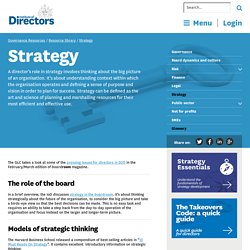

Scenario planning Schoemaker. Brain Science and Leadership Effectiveness. Brainlink Resources. 5 Ways the Best Companies Close the Strategy-Execution Gap. Executive Summary.
Treat Strategy as Evergreen In effect, a company’s strategy is the sum of decisions it effectively makes and executes over time. This mindset focuses leadership on making near-term decisions with the longer-term destination in mind, but it doesn’t presume that there is only one path from here to there. (e.g. Dell’s executive leadership team focuses on systematically addressing the issues on the company’s strategy agenda. Once they address an issue and make a decision, they allocate the resources needed and turn to the next issue on the agenda.) Value Flexibility Think of strategy as a portfolio of options, not bonds The traditional plan-then-do model treats the value of any strategy like a bond. Management forecasts the future coupon payments (or cash flows) associated with various strategies and then selects the one that has the highest discounted value. When volatility is high, however, strategic decisions should be treated more like call options. Leadership decides whether the small up-front investment is worth making as a call on potential profits. As long as the option appears “in the money,” management can continue to invest; the moment the strategy becomes “out of the money,” leadership can stop investing, cut its losses, and move on. (e.g. By treating strategic investments like options, Alphabet has avoided committing too early to new businesses. This approach has also allowed the company to double down on promising ventures and build them into profitable new businesses.) Create response mechanisms Rigorous contingency planning is as important as disciplined action planning. It requires that you identify the most important known unknowns associated with your company’s strategy, specify concrete steps to adjust course if you see an unplanned change in the external environment, and put in place mechanisms to continuously monitor market and competitive conditions. Test and learn, then test some more with the objective of moving forward, testing the waters, learning, and refining the strategy based on the results – barbaragrieve
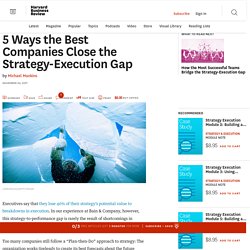
Themandarin.com. What Is Strategy Execution? Beyond Strategy: Three Steps Toward Execution. The proceeding is a follow-up to “Beyond Strategy: Three Lessons and Four Ingredients of Execution” which appeared on Ideas to Action in September 2015.
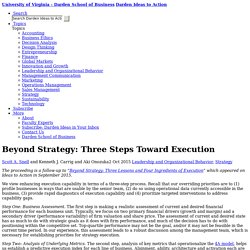
We view enhancing execution capability in terms of a three-step process. Recall that our overriding priorities are to (1) profile businesses in ways that are usable by the senior team, (2) do so using operational data currently accessible in the business, (3) provide rapid diagnostics of execution capability and (4) prioritize targeted interventions to address capability gaps. Step One: Business Assessment. The first step is making a realistic assessment of current and desired financial performance for each business unit.
Typically, we focus on two primary financial drivers (growth and margin) and a secondary driver (performance variability) of firm valuation and share price. Step Two: Analysis of Underlying Metrics. Step Three: Action Plan for Targeted Intervention. Conclusion. Beyond Strategy: Three Lessons and Four Ingredients of Execution. A couple of years ago, during a strategic review process at SunTrust, our analysis of the banking financial services industry revealed something very interesting: Strategy alone did not differentiate high- from low-performing firms.
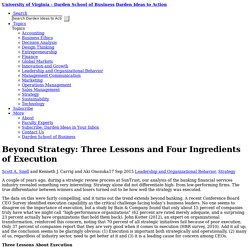
The true differentiator between winners and losers turned out to be how well the strategy was executed. The data on this were fairly compelling, and it turns out the trend extends beyond banking. A recent Conference Board CEO Survey identified execution capability as the critical challenge facing today’s business leaders. No one seems to disagree on the importance of execution, but a study by Bain & Company found that only about 15 percent of companies truly have what we might call “high-performance organizations” (62 percent are rated merely adequate, and a surprising 23 percent actually have organizations that hold them back). Seminar EkonomikaAlumni KULeuven 3dec2009. Is Your Innovation Problem Really a Strategy Problem? The Execution Trap. Strategy Execution 8CSFs. The Idea of Grand Strategy. UK Strategy Survival Guide. 20160701 Working Paper 201601 Web. 20160712 Think Piece 21. Strategy Management System.
Execution Is a People Problem, Not a Strategy Problem. Paul,* the CEO of Maxreed, a global publishing company, was having trouble sleeping.

Publishing is an industry that’s changing even faster than most other fast-changing industries, but Paul wasn’t awake worrying about his strategy. He had a solid plan that took advantage of new technologies, and the board and his leadership team were aligned around it. Paul and his team had already reorganized the structure — new divisions, revised roles, redesigned processes — to support their strategy. So what was Paul worrying about?
People. Which is precisely what he should be worrying about. In other words, your organization’s biggest strategic challenge isn’t strategic thinking — it’s strategic acting. If I were to depict the challenge graphically, it would be going from this: To this: The perils of bad strategy. Bad strategy abounds, says UCLA management professor Richard Rumelt.
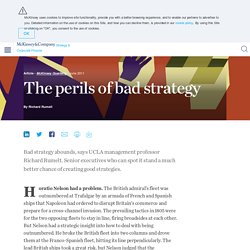
Senior executives who can spot it stand a much better chance of creating good strategies. Horatio Nelson had a problem. The British admiral’s fleet was outnumbered at Trafalgar by an armada of French and Spanish ships that Napoleon had ordered to disrupt Britain’s commerce and prepare for a cross-channel invasion. The prevailing tactics in 1805 were for the two opposing fleets to stay in line, firing broadsides at each other. Strategy - Institute of Directors in New Zealand. The GLC takes a look at some of the pressing issues for directors in 2015 in the February/March edition of boardroom magazine.
